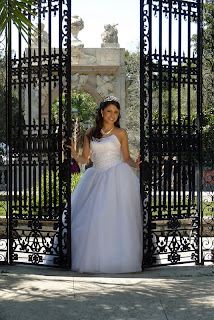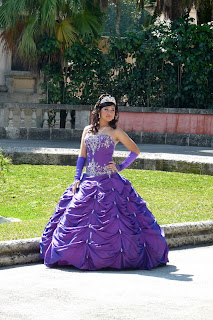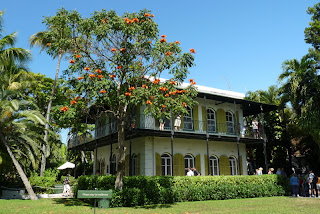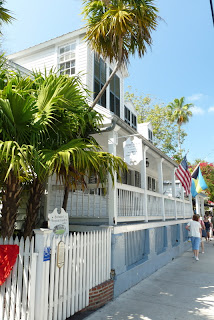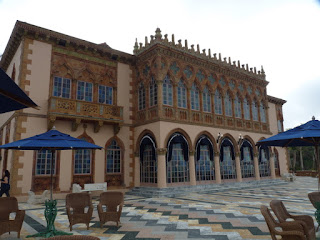Fort Lauderdale is all about water - the Atlantic Ocean, the Intracoastal Waterway, rivers and canals. Water seems to surround us - it's relaxation, it's transportation, it's inspiration. Everyday life seems to revolve around the water, and it's a big part of the city's casual, low-key atmosphere.
The Atlantic Ocean is why most visitors come here, and the weekend crowds were reminiscent of the old movie, "Where the Boys Are."
A long section of the city's coastline is fronted by a pedestrian promenade and what locals call the 'wavewall' - a flowing, serpentine wall cut by decorative entranceways to the beach and water. The palm-lined walkway is well-used by joggers, inline skaters and folks out for a stroll. A great spot for people-watching!
There's good reason why Fort Lauderdale is known as the 'Venice of America' and the 'Yacht Capital of the World.' The city has 300 miles of navigable waterways - the Intracoastal Waterway, the New River and the canals that cut away from these are like side streets off a main thoroughfare. These create a honeycomb grid where boats replace cars as the means of transportation. Waterways connect all parts of the city - business, residential, arts, historical, and of course, the beaches.
The best way to experience this unusual road system is by boat, so we hopped aboard the 'Jungle Queen: for a sightseeing cruise along the New River. The legend of New River is a bit dubious - supposedly, hundreds of years ago, a powerful storm battered the area. The Indians fled to the Everglades to wait it out. When they returned to their homes, they found a river where one had never been before. Everyone began shouting about the "new" river and the name stuck.
Legends today in Fort Lauderdale seem to be made from money - manifest as big boats and bigger houses. Our guide rattled off names of movie stars, television celebrities, sports stars and business leaders as we floated past multi-million dollar mansions and luxurious yachts.
Legends today in Fort Lauderdale seem to be made from money - manifest as big boats and bigger houses. Our guide rattled off names of movie stars, television celebrities, sports stars and business leaders as we floated past multi-million dollar mansions and luxurious yachts.
We went under seven pink "Pepto-Bismol" draw bridges, 2 railroad draw bridges, and the massive bridges of I-95. Every inch of the way there were houses, boats and canals off to either side. Most of the houses here are built on man-made islands created when the canals were dug.

We stopped for a stretch at one of these islands that still has some trees and other vegetation - and refreshments and gift shops and a crazy man who demonstrated the fine art of alligator wrestling. Fortunately, no body parts were lost this day and the animals seemed only mildly annoyed by this foolishness.
Wildlife was a bit scarce on this trip, but we did see some iguanas sunning on the sea wall and a manatee under a dock.
After lunch, we set off on foot to explore 'old town' Fort Lauderdale. By boat, it didn't look so far away; by land, it was a bit over three miles from our beachfront hotel. In the 80-degree sunshine, it seemed a lot longer.
As for history, Fort Lauderdale had its beginnings in the late 1800's when Frank Strahan established a trading post on the New River. This 1901 building has served as a trading post, restaurant, and private home. Tired feet demanded a rest, so we stopped at a side walk cafe for a tall, cold drink. It was Saturday afternoon, and everybody was out for a stroll - another good spot for people-watching!
We hopped on the trolley for a ride back to to beach, where we took another stroll along the promenade. The beach crowd made the in-town folks seem pretty tame - from over-dressed to barely dressed, and everything in between. We had dinner out on the beachfront before adjourning to the hotel pool area to watch a king-sized chess match.
Enough already ... time to move on.
MIAMI
Miami has long been known as a winter playground for the rich, and we stopped by for a visit to Viscaya, the winter residence of James Deering, an agricultural industrialist whose riches came from the International Harvester Company. He must have had money to burn, because he spent plenty to create and furnish this lavish home inspired by the palaces of Europe.
Deering chose a site on Biscayne Bay for his home because of the location's temperate winter climate and his appreciation of the native hardwood hammock. At the time of Viscaya's construction between 1914-1916, Miami's population was around 100,000 - and over 1,000 of those were employed in building the house, gardens, farm, livestock areas and other service facilities covering 180 acres.
Although furnished with 16th through 19th Century European furniture and arts, Vizcaya was built to have all the modern conveniences of its time: central heating, an automatic electric telephone switchboard, two elevators, refrigeration, a central vacuum system, and a fire control system.
We approached Vizcaya by land, through the native forest of rockland hammock and then down the main drive bordered by water cascades and fountains.
The opposite (east) side of the building looks out over Biscayne Bay, where early Spanish explorers came ashore to replenish fresh water supplies.
Looking out toward the bay, the Stone Barge was intended as a breakwater for small boats and a location for dinners and parties.
At one end of the sea wall is a lattice-roofed Tea House where Deering's guests would watch arrivals and departures while enjoying refreshments.
Beyond the Tea House lie ten acres of formal gardens, planned as an extension of the house and conceived as a series of outdoor rooms. The gardens are said to be an excellent example of Italian garden design (stone - in statuary and other features; water - in fountains, pools and cascades; and plenty of clipped and trained plants).
At the far end of the formal gardens, there is a miniature house, or casino, which offered guests a place for relaxing away from the formality of the main house. There are rooms on either end connected by an open loggia which provides vistas of the formal gardens, the main house, and the tropical jungle further south.
Inside the house, no cameras allowed, so no pictures to show here. The ground floor as 18 rooms, built around a large covered courtyard. These were the more 'public' rooms, where Deering entertained guests and visitors. Upstairs are another 18 rooms, including Deering's office and private quarters, the kitchen and breakfast room, as well as guest rooms.
As a bonus during our visit, we saw a couple of Hispanic families having photographs made of their 15-year old daughters. This is a coming-of-age tradition, with pictures to be published in the local paper. Pretty girls.
All in all, Vizcaya is quite a grand and glorious place, and well worth a visit.
KEY WEST
Off the southern tip of Florida, some 60 miles beyond Miami, the Florida Keys resemble a broken necklace, each island a charm on a 125-mile chain of 1,700 islands linked by 42 bridges. These bridges, the longest of which is seven miles in length, give this stretch of U.S.1 the nickname of The Overseas Highway.
On this trip, islands along the way to Key West were mostly names on a sign post to drive past. Marathon Key gets a special mention since this was fisherman Dan Wheeler's favorite after Christmas fishing spot. Fran joined him one year in the late 70s, but nothing really look familiar this time around (after all, we spent most of our daylight hours out in the boat - who knew there was life on the island?).
Our destination this time is Key West - carefree party town and sportsman's paradise. Since the 19th century, pirates, shipwreck salvagers, shipbuilders, cigar makers, spongers, rumrunners, artists, writers, and Caribbean immigrants (mostly Bahamian and Cuban) have been drawn to this place. Between the 1820s and 1860s, shipwreck salvagers, known as wreckers, found their fortunes in boatloads of treasure from ships that wrecked on the nearby coral reefs. In the mid-1800s, spongers reaped their harvest from local waters. In the late 1800s, transplanted Cubans turned cigar-making into big business. The late 1800s to early 1900s saw the growth of the pineapple industry, while key lime farmers turned a tidy profit around the turn of the 20th century.


Fortunes were made and lost, but everything changed when Henry Flagler's railroad connected the Keys to the mainland in 1912. Tourism became THE business, and even more so with the 1938 completion of the Overseas Highway.
Of Key West's many attractions, its sunsets are among the most popular and amazing experiences. Every night, dozens of street vendors and performers gather near the water at Mallory Square. Jugglers, palm readers, contortionists, musicians, and other entertainers vie for the attention (and donations) of the crowds of spectators who begin assembling about an hour before sunset. It looks a little like a waterfront carnival - a cross between the Gong Show and the outpatient clinic at Bellevue.


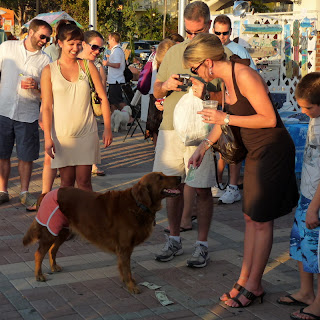

In spite of the mob scene, the sunset didn’t disappoint. As the sun sank into the horizon, everyone cheered and then wandered off in search of dinner - or perhaps another beer.
We were in Key West for three nights, so we had ample opportunity to enjoy the sunsets - and to sample island cuisine. Worth mentioning:
* El Meson de Pepe: A family-owned restaurant known for its Cuban-Island Cuisine. We tried the conch fritters and a ‘completa’ - a plate of side dishes including yellow rice, black beans and ripe plantains. Washed it down with a very fine margarita.
* Kelly's: Housed in the original headquarters of Pan American Airways, with numerous aviation artifacts scattered around. The bar is shaped like an airplane wing and the ceiling fans look like the rotary engines of an airplane. Coops hanging over the bar once held homing pigeons that were released when the plane reached its final destination, signaling the folks back home that it had landed safely.
* Veggie Cafe: A small place a bit off the main drag. Nice vegetables, outstanding bruschetta and world class microbrewery root beer.
* B.O.'s Fish Shack: An old truck and shack in a corner of a parking lot. The fish sandwiches, on Cuban bread with key lime sauce, are legendary for a reason. It’s a dive, but maybe the best meal we had on the island.
* B.O.'s Fish Shack: An old truck and shack in a corner of a parking lot. The fish sandwiches, on Cuban bread with key lime sauce, are legendary for a reason. It’s a dive, but maybe the best meal we had on the island.
* Kermit's Key Lime Shoppe: Key lime overload is the theme here - right down to the green shoes and chef’s hat on the proprietor, Kermit Carpenter. We tried a frozen slice of pie - on a popsicle stick and dipped in chocolate. The Food Network named this creation one of the Top Ten Desserts in the US - it was sinfully delicious.
People-watching is as good as sunset watching, especially along Key West's main thoroughfare, Duval Street. Duval Street stretches from coast to coast across the island, and all types of folks saunter along without a care or a stare - beach bums, gay couples, cruisers on shore excursions, Hemingway look-alikes, drag queens, retirees, honeymooners, strutting roosters, writers, musicians, even an occasional celebrity. Everybody's here to relax and have fun.
A word about the roosters. It seems that chickens are a protected species here. Cuban immigrants raised chickens for cock-fighting, and when the local government banned the sport, the angry owners released the birds ... all over the city. About the same time, Key West was declared a bird sanctuary, and - presto - 'free range' chickens. Nobody seems to mind the hens, but the roosters have an unfortunate tendency to crow at all hours.
The big cruise ships dock right near Mallory Square - their size never ceases to amaze. Fortunately, they don't stay too long, and the view is much nicer without them. The weather was delightfully warm and sunny for our entire trip. The average year round temperature is 77 degrees. Nice.
Kino Sandals is a family business started by a couple of Cuban refugees in 1966. We visited their factory, where folks in the back were making sandals and folks up front were selling them - almost as fast as new ones were being assembled. Margaret now is sporting a new pair of Kino’s finest, handmade in Key West.
They say that whenever winter chill sets records in much of the country, locals like to huddle around the pot-bellied stove-like monument marking the southernmost point in the continental United States. The marker, actually built to resemble a buoy, stands at the furthest south tip of the island of Key West. From here, it is only 90 miles to Cuba and nearby there is a plaque commemorating the brave Cubans who have drowned trying to get to America.
On the top of the monument is painted the logo of the Conch Republic. Twenty years ago, angry about U.S. Customs Officials requiring proof of citizenship to leave the Keys (leading to a 20-mile traffic jam that took days to untangle), the good folks of Key West seceded from the Union - declaring themselves the Conch Republic. The U.S. Government did not look kindly on this action, and before long West Key surrendered and requested foreign aid. The aid never arrived but the government did abandon the idea of checking ID’s on people driving north on the Overseas Highway.
The Key West Lighthouse was built in 1847 to aid ships navigating the dangerous reefs off the lower keys. In later years, it was said to be used by Ernest Hemingway to find his way home after a long night drinking at Sloppy Joe’s Bar - the lighthouse is just across the street from Hemingway’s house. The lighthouse was de-activated in 1969 and today it stands sentinel over historic old town Key West.
The Ernest Hemingway House was home to one of America’s most honored and respected authors. Ernest Hemingway lived and wrote here for more than ten years. While here, he wrote some of his best known works - novels and short stories that earned him the Nobel Prize and the Pulitzer Prize.
Hemingway had a routine of writing during the early mornings when the temperature was the coolest. His studio was in the backyard above the carriage house - here he wrote nearly three-fourths of his works, including "For Whom the Bell Tolls" and "To Have and to Have Not." His original Royal typewriter and his original Cuban cigar-maker's chair are as he left them.
In the afternoons, Hemingway was most often on his boat, sport-fishing for big game fish. Sometimes, he and his friends went for days or weeks at a time in pursuit of giant tuna and marlin. Pictures of his prize catches are found all over the house - as are trophy mounts and skins brought back from African safaris and hunting expeditions out west.
In the evenings, Hemingway could be found at Sloppy Joes, a bar owned by his friend Joe Russell. His drinking was legendary, but so were his listening skills - he met all sorts of interesting people - from the well-to-do to the down-on-their-luck fisherman and wreckers. The people he met at Sloppy Joes frequently appeared as characters in his writings.
The descendants of Hemingway’s cats are a very visible and living link to the past. The story goes that Hemingway made the acquaintance of a sea captain who owned an unusual six-toed tomcat. Upon his departure from Key West, the captain presented the cat to Hemingway. Today there are more than 40 cats wandering around the house and grounds, and many of them still possess the unusual six toes. When asked why he had so many cats, Hemingway quipped, "One cat just leads to another."
Florida is the only state in the continental U.S. to have extensive shallow coral reef formations near its coasts. These reefs extend from near the town of Stuart, on the Atlantic Coast, to the Dry Tortugas, west of Key West in the Gulf of Mexico. We took a late afternoon glass bottom boat ride in hopes of seeing the large reefs on the Atlantic side, but it was too windy to head out to sea - instead we visited the coral formations in the Gulf. We did see some coral, some fish and lots of sponges, but the highlight of the trip came as we left the shallow reef to head back to Key West. A group of bottle-nose dolphins came to play - they swam right in front of and to the side of our boat. There were at least six of them and they put on quite a show for those of us lucky enough to be on the bow.
Harry Truman's Little White House is in the old Navy base. This building once served as the command headquarters of the naval station during the Spanish American War, World War I, and World War II. It was first used by Truman as the winter White House in 1946. Today it is a living museum, still used as a retreat and place of government business by Presidents and national leaders. Note the sand sculpture of Truman near the house.
Within the area of the old naval station, the old officers' quarters have been converted into pricey condominiums and just about every other home is a registered national landmark.
Just across the street from the Little White House is another lovely old home known as the Audubon House. The house was built in the 1800's by John Geiger, a harbor pilot who got rich 'rescuing' treasures from ships that wrecked on the off-shore reef. John James Audubon visited the Florida Keys in 1832, probably before the house was built. While in the Keys, Audubon sighted and drew 18 new birds for his "Birds of America" collection, but there is no evidence that he was ever near this house. When the house was restored in the 1950's, it was named in his honor and today. The legend persists that Audubon did at least one drawing here. No matter, it's a beautiful old house and the gift shop sells lots of nice Audubon prints...
We found the Old Town Trolley to be a great boon to sightseeing. It travels a twisting loop all over the island and comes equipped with a driver who provides entertaining commentary. We had a two-day pass, with unlimited on/off - good way to get a rest while still getting around to see things. The Key West Cemetery was on the trolley route - here the tombstones read like a historical who's who of the Conch Republic. The wealthy and prominent ordered fancy stone monuments, while those of modest means placed markers of brick, cement or tile. Symbols and epitaphs provide insight into some of the characters who made Key West what it is today. Some of the best epitaphs: I Told You I Was Sick -- At Least I Know Where He is Sleeping Tonight --I'm Just Resting My Eyes --The Buck Stops Here.
Key West’s oldest house is at 322 Duval Street. It sits on 3-foot tall pilings, a safeguard from the days when storm tides would flow down Duval Street. The house also boasts the city’s only remaining outside cookhouse - cookhouses were often not attached to the main buildng in case of fire, not an uncommon problem with wood-burning stoves.
Around the corner is a grand old house known as the Robert Frost Cottage. Hemingway wasn't the only writer to fall in love with Key West - Robert Frost spent many winters here between the 1940s and 1960 - just imagine him sitting among the flowers in the tropical backyard garden, writing about snow in the New England woods.
The old Customs House was built in 1891 in the Romanesque style for all such Federal buildings. That includes the steep roofline, designed to prevent snow accumulation. So far, it hasn't been tested since it has never snowed in Key West. The building today houses the Museum of Art and History.
Just to make it official - we made it to the very end of the road, U.S.#1, that is. It is marked by one of the most stolen road signs in America.
FORT MYERS
We stopped at Manatee Park near Fort Myers in hopes of seeing manatees which gather there along the Caloosahatchee River during the winter months. Alas, the warm weather has sent them north earlier than usual. We saw only one, but enjoyed a nice walk along the river among the live oaks and Spanish moss.
SARASOTA
SARASOTA
When the Ringling Brothers and Barnum & Bailey Circus moved its winter quarters to Sarasota in 1927, this serene seaside resort was transformed into a hub of circus activity. The move attracted famous circus families and performers from around the world, and Sarasota became known as Circus City, USA, the Home of the American Circus.
In 1960, the circus moved its winter quarters to Venice, Florida, but today the Ringling influence is still prevalent throughout the area. We stopped at the Ringling estate that is now home to the Ringling Museum of Art, the Ringling's personal home of Ca' d'Zan, and the Ringling Circus Museum.
The estate grounds are a fine place for a stroll. There are many native plants, including some really huge banyan trees. Banyan trees have aerial prop roots, which grow into thick woody trunks, allowing the tree to spread out laterally over a wide area.
As we approached the Ringling Home, there was a group of artists hard at work- trying to paint the old live oak draped with Spanish moss.
The house itself is a bit like a palace - it is said to be the last of the Gilded Age mansions to be built in America. Completed in 1925, the house has 56 rooms filled with art and elaborate furnishings. Nice place to visit, but wouldn't want to live there.
The Ringlings were avid art collectors. From the mid-1920s through the 1930s, they amassed nearly 700 paintings, sculptures, decorative pieces and tapestries. To preserve and display these, the Ringlings had their own museum built right on the estate.
The Museum of the Circus celebrates the American circus, its history, and its unique relationship to Sarasota. The museum houses huge parade and baggage wagons, sequined costumes, circus posters, and other memorabilia and artifacts of the circus of the past and today.
Also on exhibit here is the "Wisconsin," the private rail car that John and Mable Ringling built in 1905. They certainly traveled in style as they moved around the country on business and with the circus. In an adjacent building is the world's largest miniature circus: a replica of Ringling Brothers Barnum & Bailey Circus from 1919-1938, built over a 50-year period by master model builder (and circus fan) Howard Tibbals.
SILVER SPRINGS
Silver Springs is said to be the world's largest formation of clear artesian springs; over a dozen springs form the headwaters of the crystalline Silver River, which flows to the St. John's River and on to the Atlantic Ocean. The springs release more than 550 million gallons of 99.8% pure water every 24 hours - enough to supply New York City.
We took a ride on a glass bottom boat - invented here in 1878 - for a wonderful look at an underwater world of fish, turtles, and crustaceans. In some of the deeper springs, there are even artifacts from ancient Indian tribes (a dugout canoe) and early Spanish explorers (a rowboat).
We also walked through some of the wildlife exhibits in the cypress swamp habitat of the park. Alligators were plentiful, most of them 11-13 feet in length.
Smaller, but much more interesting, was a pair of white (albino) alligators. These critters aren't very competitive in the real world because they get sunburned too easily.
Another interesting exhibit allowed a good look at the rare Florida panthers. Less than 100 of these beautiful animals remain living in the wild, making this a highly endangered species.



















